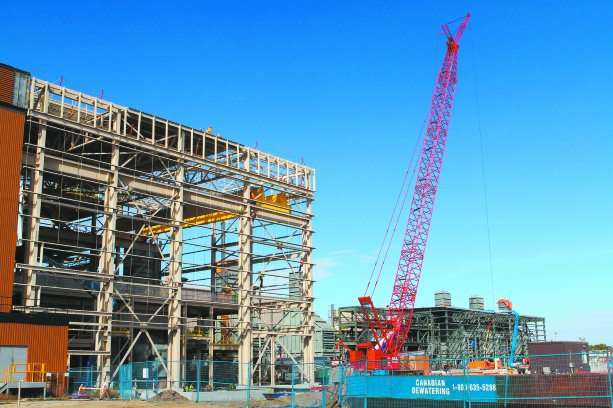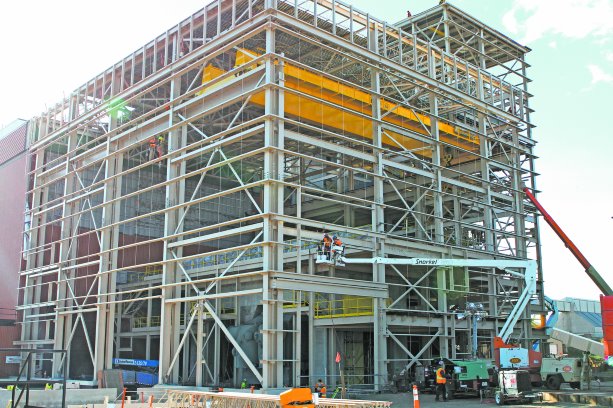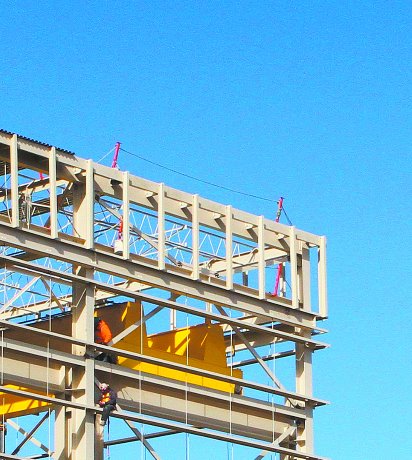One of the most expensive capital projects in Saskatchewan history is showing considerable progress, but it hasn’t come without significant challenges.
Construction of the $514 million expansion to SaskPower’s Queen Elizabeth power station in Saskatoon got underway last September.
Now, the skeleton frames of massive additions are in place.
When complete, the buildings will cover 25,000 square metres, the equivalent of four football fields.
The original plant was built in 1957 and housed two turbines.
It underwent expansion in the early 1970s, 2002 and 2010.
With more natural gas and steam turbines now being added – coal has been phased out – it will bring the number of turbines to 16.
Six heat recovery boilers will result in efficiency being improved 15 to 20 per cent, and the D plant will become a combined cycle facility by converting waste heat from gas turbines into steam to power other turbines.
In terms of expenditures, the project has passed the 50 per cent mark.
In regards to labour, it is about 35 per cent complete.
The new turbines are expected to be in use by next September.
The hurdles cleared to get to this point have been numerous.
The late delivery of some equipment and supplies has been a trial, agreed Tony Finn, director of construction with SaskPower, and Yan Wang, the project manager.
Meanwhile some materials not required until much later have arrived early, Finn added.
Bob Niemeier, deputy construction manager with contractor Alberici/Burns and McDonnell, said extensive digging through three metres of frozen ground to pour 12,000 cubic metres of concrete for the foundation proved difficult.
The excavating team uncovered various artifacts from a previous dig, including pieces of cable.
Foundation concrete has been the most costly construction material for the project.
That’s followed by piping, steel building and pipe rack, power cables and foundation piles.
Close to 1,400 steel H-piles, 9 to 15 metres in length, have been driven into the ground to support the structure.
Then, the month of June brought heavy rain.
That necessitated the rebuilding of dirt roads leading to the site as trucks – some carrying loads of 125 tons or more – were vulnerable to getting bogged down.
A milestone was reached Oct. 4 when the 200-ton converter was put in place.
It converts steam back into water.
To prevent returning winter weather from becoming too great a burden, the plan is to close off the new additions by late November.
It will be more comfortable for electrical and mechanical workers when heat can be generated and retained within the new buildings, Wang said.
There are, in total, about 360 workers on location at the power station.
About one-third of those employees are working a night shift to reduce congestion at the site.
Manz said one of the things he was sure to mention to contractors in his initial meetings with them was that winter conditions in Saskatoon are not to be taken lightly.
"Minus 40 is real. It happens here," he said.
One job taken care of before the deep chill sets in was burying about 365 metres of steel and concrete pipe, which ranges from 1.5 to 2.5 metres in diameter.
The power station, which has its own pump house, requires 757,000 litres of water per minute from the South Saskatchewan River to keep the facility from overheating.
The water is returned to the river afterwards. Other obstacles are distance and language.
Two of the major suppliers for this project are Hitachi, for gas turbines, and Fuji, for steam turbines.
Both are based in Japan.
Fuji is a new supplier for SaskPower, but the utility has a 40-year relationship with Hitachi.
Nevertheless, scheduling teleconferences with representatives of those overseas companies means overcoming the 15-hour time difference, Wang pointed out.
The upgrade will enable the power station to produce more than 600 megawatts (MW), an increase from the existing 430 MW limit. Saskatoon’s power demand has peaked at close to 360 MW, said Randy Manz, director of western plants for SaskPower.
The fast-growing city currently has 250,000 residents and the upgrade will allow SaskPower to accommodate another 205,000 households.

1/3
Derek Neary
2/3








Recent Comments
comments for this post are closed